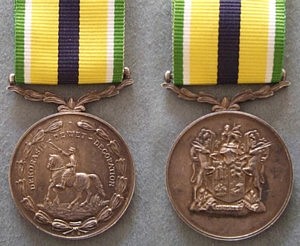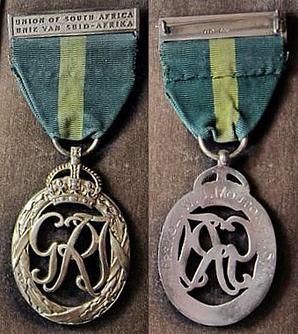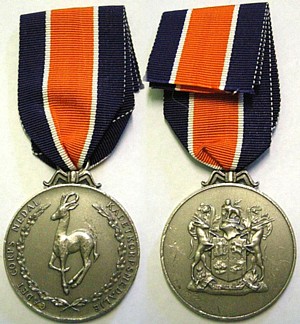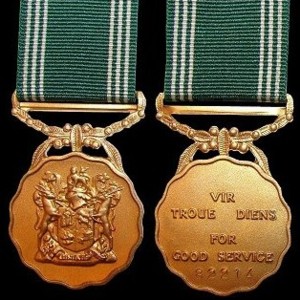
The Tshumelo Ikatelaho - General Service Medal was instituted by the President of the Republic of South Africa on 16 April 2003, and came into effect on 27 April 2003. It can be awarded to all ranks who have participated in military campaigns or operations which, while not warranting the institution of particular campaign medals, still justify the award of a medal for general service. The bilingual title of the medal is in Tshivenda and English.

The Medalje vir Troue Diens - Medal for Loyal Service was instituted by the President of the Republic of South Africa on 16 April 2003 and came into effect on 27 April 2003. It can be awarded to all ranks whose character and conduct have been irreproachable and who have completed ten years of qualifying service.

The Van Riebeeck Medal, post-nominal letters VRM, is a military decoration for bravery which was instituted by the Union of South Africa in 1952. It was awarded to other ranks for distinguished service in the field.

The Permanent Force Good Service Medal was instituted by the Republic of South Africa in 1961, when South Africa became a republic, to replace the Union Medal. It was awarded to Permanent Force members of the South African Defence Force for eighteen years of service and good conduct.

The De Wet Decoration, post-nominal letters DWD, is a military long service decoration which was instituted by the Republic of South Africa in 1965. It could be awarded to members of the Commandos, the rural civil defence component of the South African Defence Force, for twenty years of efficient service and good conduct. The decoration was initially reserved for officers, but it was made available to all ranks in 1986. A clasp could be awarded after thirty years service.

The Efficiency Decoration (South Africa), post-nominal letters ED, was instituted in 1930 for award to efficient and thoroughly capable part-time officers in the Citizen Force of the Union of South Africa after twenty years of service. The decoration superseded the Colonial Auxiliary Forces Officers' Decoration.

The John Chard Medal is a military long service medal which was instituted by the Union of South Africa on 6 April 1952. Until 1986, it was awarded to members of the Citizen Force of the South African Defence Force for twelve years of efficient service and good conduct. The period of qualifying service was reduced to ten years in 1986.

The Cadet Corps Medal is a military medal which was instituted by the Republic of South Africa in 1966. It could be awarded to officers in the School Cadet Corps for twenty years efficient service. A clasp could be awarded after 30 years qualifying service.

The General Service Medal is a military campaign medal which was instituted by the Republic of South Africa in 1987. It could be awarded to members of the South African Defence Force from 1 January 1983, for operational service inside South Africa in the prevention or suppression of terrorism or internal disorder, or the preservation of life, health or property, or the maintenance of essential services and law and order, or crime prevention.

The De Wet Medal is a military long service medal which was instituted by the Republic of South Africa in 1987. It was awarded to members of the Commandos, the rural defence component of the South African Defence Force, for ten years of efficient service and good conduct.

The Good Service Medal, Bronze, originally named the South African Defence Force Good Service Medal, Bronze, is the junior of a set of three South African military medals which was instituted by the Republic on 1 July 1975. It was awarded to members of all elements of the South African Defence Force for ten years of exemplary service, but was restricted to Permanent Force personnel from 1993.

The Good Service Medal, Silver, originally named the South African Defence Force Good Service Medal, Silver, is the middle member of a set of three military medals which was instituted by the Republic of South Africa on 1 July 1975. It was initially awarded to members of all elements of the South African Defence Force for twenty years of exemplary service, but was restricted to Permanent Force personnel from 1993.

The Good Service Medal, Gold, originally named the South African Defence Force Good Service Medal, Gold, is the senior of a set of three military medals which was instituted by the Republic of South Africa on 1 July 1975. It was initially awarded to members of all elements of the South African Defence Force for thirty years of exemplary service, but was restricted to Permanent Force personnel from 1993.

The Union Medal was instituted by the Union of South Africa in 1952. It was awarded to Permanent Force members of the South African Defence Force for eighteen years of service and good conduct.

The Faithful Service Medal was instituted by the State President of the Republic of Transkei in 1987, for award to all ranks as a long service medal.

The Long Service Medal, Gold was instituted by the President of the Republic of Venda in 1985, for award to all ranks for thirty years exemplary service.

The Long Service Medal, Bronze was instituted by the President of the Republic of Venda in 1985, for award to all ranks for ten years exemplary service.

The Closure Commemoration Medal is a military commemoration medal which was instituted by the President of the Republic of South Africa in 2010, to commemorate the disbandment of the Commandos, the rural defence component of the South African National Defence Force.

The Service Medal in Gold was instituted by the President of the Republic of South Africa in April 1996. It was awarded to veteran cadres of Umkhonto we Sizwe, the military wing of the African National Congress, for thirty years exemplary service.

The Service Medal in Bronze was instituted by the President of the Republic of South Africa in April 1996. It was awarded to veteran cadres of Umkhonto we Sizwe, the military wing of the African National Congress, for ten years service.






















